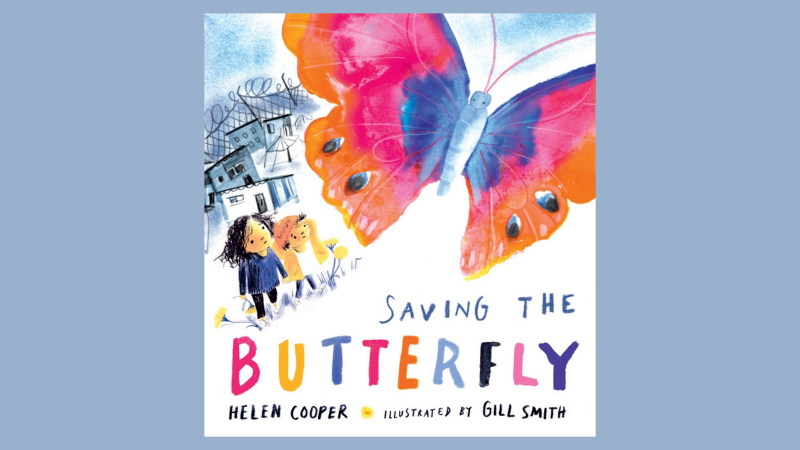For help, advice and telephone ordering call our team on 0121 666 6646
Are you sure you wish to delete this basket?()
This action cannot be undone.
Sorry, something went wrong
Please report the problem here.
Saving the Butterfly: Q&A with Helen Cooper

February 10th 2022
Helen Cooper is an author and illustrator whose work includes classic titles such as The Bear Under the Stairs, Pumpkin Soup, The Baby Who Wouldn’t Go to Bed and Tatty Ratty. Her books have been translated into 30 languages to support developmental reading and writing, and won many awards including the Kate Greenaway Medal – twice.
In her newest picture book Saving the Butterfly, a little girl finds hope in a butterfly she finds as she and her little brother try to start a new life in a new land after being the only survivors of a boat of refugees.
Saving the Butterfly is a beautiful picture book. Did you have a favourite school picture book growing up?
I had so many favourites: mostly fairy tales and poetry. But there was one picture book that I was very attached to which may have had some bearing on themes I tend to revisit in my own books.
The book was called Bunny’s Magic Tricks: a Tom and Jerry sort of story about a young magician rabbit who steals a puppy’s bone and teases the poor dog with his not-very-funny magic tricks. The best part: there was a choice of three endings according to how you folded the final page. Choose the first option, and Bunny continues with his tricks while Puppy watches glumly. In the second, the puppy escapes with his bone leaving a sobbing bunny behind. In the final option, Bunny and Puppy make friends and dance into the sunset. This graphic portrayal of their opposing feelings and how they could learn to get along really appealed to me. And I think I quite liked controlling how they would behave too – controlling fictional characters is, after all, something that writers are allowed to do. In fact, finding a way of representing the different feelings of my characters and how they learn to look after one another has been a theme in my work, especially in the Pumpkin Soup trilogy of books, and now in Saving the Butterfly.
The biggest influence on my illustrations (entirely because of the pictures) were the Favourite Nursery Rhymes and ABC of the great Brian Wildsmith. His use of colour has always been a major influence on my artwork, and, when I wrote Saving the Butterfly, I was hoping the illustrator might use a Wildsmith-like freedom of colour when they depicted the butterfly. I never said so, in fact I tried not to even think much about the illustration before I saw it, because I didn’t want to get in the way of what another illustrator could bring to the book. But I was thrilled that Gill Smith’s butterfly has a rainbow brilliance that reminds me a little of Wildsmith.
What inspired the idea of the butterfly in this story?
When Denise Johnstone-Burt at Walker Books asked if I could write a picture book text for another illustrator, I knew here was an opportunity to write a story that might work best with a looser and more suggestive style of illustration than my own. Many of my other books take a gentle look at childhood anxieties: the fear of losing someone, or being lost, or even the fear of a bear living under the stairs. I was an anxious child, so I try to tread lightly, with humour in the illustrations to counter the theme. This time though, I aimed for a different tone. I set out to find a gentle and symbolic way of writing a story about the anxiety that can follow trauma.
Early on a brother and a sister came to mind, who react very differently in a crisis. But the lyrical phrases that I search for when I write a picture book only surfaced when I thought of using a butterfly as a metaphor for the girl’s courage and her fragile mental health. The fluttering feeling of dread that comes from too much adrenaline is often described as “butterflies inside”. But also, I knew a beautiful wild butterfly could be a strong symbol for the spirit of survival.
There are themes of sadness and anxiety in Saving the Butterfly. What was the experience of writing about such big themes for children?
We know that anxiety disorders are on the increase, yet children often find it hard to express themselves. So for some time I’ve wanted to write a simple story about severe anxiety. All the same, I didn’t set out to write a book about the refugee experience. When I first began it, I was thinking more of the flooding that has blighted the UK in recent years. But as my story unfolded, with the symbols of the butterfly and the dark sea, the children evolved into refugees who had lost everything. There could be no easy resolution for them. And although the dark sea represents any sort of trauma – and all the dark seas that people have fled from in the past, as well as now – I felt daunted. I worried about winding myself into some real person’s tragedy. For a while I put the story aside.
I am not a refugee, although my parents on both sides were the children of immigrants, Jewish on one side, Irish catholic on the other. Both families came over the sea with very little and found refuge in this country. I think about that often. And after a while I returned to the story and it flowed easily. And though the hope at the end of the book had to be fragile, I hope that with Gill Smith’s poignant yet powerful illustrations, it will become a book that children will want to share.
How do you hope children will engage with Saving the Butterfly?
My childrens books about diversity are multi-layered because I’d like readers to return to them to think more about the characters. Hopefully, they’ll talk about them too. If I was sharing this book with children, I would probably introduce it by saying that this is a story about two children who have lost everything; and then explain that after people have survived a tragedy, sometimes they have feelings that are very hard to bear.
Children will find their own way to respond to the story. Some of them may find it easiest to relate to the trapped wild butterfly, or the small boy who knows his sister is in deep distress and tries to find a way to help her feel better. Others will identify with the young girl made prisoner by her own traumatic memories and anxiety, and her courage in taking the first steps towards recovery despite a very uncertain future. Or they might even prefer to think of the larger real-life story that I stumbled into when I wrote about two children being rescued from a dark sea.
Gill Smith has woven all these stories together, dancing between light and dark in her delicate, compassionate, illustrations. Saving the Butterfly can only be a metaphor for the harsh and overwhelming reality facing so many people, but I’d be so overjoyed and humbled if our book helped readers hold refugee children in their thoughts longer than they would have if they hadn’t read it.
A lovely way to end a guided reading session with the book could be to ask the children to draw or paint their own butterfly to symbolize wishes for everyone in similar circumstances.
Saving the Butterfly is out now.
Download Saving the Butterfly Teachers' Notes
You can find out more about Helen Cooper on her website www.helencooperbooks.co.uk




